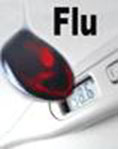
FRIDAY, Jan. 10, 2014 (HealthDay News) — Flu season continues to tighten its grip on the United States, with 35 states now experiencing widespread influenza activity, federal officials reported Friday.
The flu seems to be hitting young and middle-aged adults the hardest this year, rather than seniors or children, said Dr. Michael Jhung, a medical officer in the U.S. Centers for Disease Control and Prevention’s Influenza Division.
About 61 percent of the 2,622 flu-related hospitalizations this season have been for people between 18 and 64 years old, Jhung said. Typically, seniors 65 and older account for more than half of flu hospitalizations during a season.
This could be because the H1N1 strain of flu is the most prevalent this season, and most younger adults don’t get a flu shot, said Dr. Daniel Spogen, chair of the department of family and community medicine at the University of Nevada School of Medicine.
“The ones that tend to be sick this season are young and otherwise healthy adults,” added Spogen, who’s also a board member of the American Academy of Family Physicians. “If you take a look at the data, the people who are getting sick enough to be hospitalized are the ones who didn’t get their flu shot.”
Across all age ranges, about 40 percent to 45 percent of people get an annual flu shot, Jhung said. But only 31 percent of people 18 to 49 years old usually receive a flu vaccination, he said.
Young and middle-aged adults also were disproportionately affected during the 2009 H1N1 flu pandemic, Jhung added.
Another reason for that trend: Until the 2009 pandemic, the H1N1 flu strain had been dormant for several decades, leaving younger adults with little immunity to the virus.
Still, the number of deaths related to either the flu or pneumonia this season remains slightly below epidemic levels, the CDC said.
An estimated 6.9 percent of all deaths in the United States this season have been caused by flu or pneumonia — just under the epidemic threshold of 7.1 percent. Ten children have died from the flu so far this season, the CDC said.
The H1N1 strain accounts for more than half of the influenza virus specimens that have been tested this season, the CDC said.
“H1N1 viruses continue to predominate across the country,” CDC spokeswoman Erin Burns said. “Anyone aged 6 months and older who has not gotten a flu vaccine yet this season should get one now. All flu vaccines are designed to protect against H1N1 viruses.”
The U.S. Southwest — Arkansas, Louisiana, New Mexico, Oklahoma and Texas — is the region hardest hit by the flu this season. This week, nearly 9 percent of all doctor’s office visits in that region were due to flu-like symptoms, outstripping the illness rates of all other parts of the country.
According to the CDC, flu activity by state breaks down as follows:
- Widespread activity in 35 states — Alabama, Alaska, Arkansas, California, Colorado, Connecticut, Georgia, Idaho, Illinois, Indiana, Kansas, Kentucky, Louisiana, Maine, Massachusetts, Minnesota, Missouri, Montana, Nebraska, New Hampshire, New York, North Carolina, North Dakota, Ohio, Oklahoma, Oregon, Pennsylvania, Rhode Island, South Dakota, Texas, Utah, Virginia, Washington, Wisconsin and Wyoming.
- Regional activity in 12 states — Arizona, Florida, Iowa, Maryland, Michigan, Mississippi, Nevada, New Jersey, New Mexico, South Carolina, Tennessee, and West Virginia.
- Local activity in two states — Delaware and Vermont.
Only one state, Hawaii, remains largely flu-free.
Jhung and Spogen recommend that everyone get a flu shot, especially people between 18 and 64.
People also need to be sure to practice good hygiene by washing their hands often, covering their cough or sneeze, and staying home from school or work when sick, Spogen said.
“People kind of lose sight of influenza being like any other virus,” he said. “The best thing you can do is practice the kind of hygiene we always recommend.”
More information
For more on flu, visit the U.S. Centers for Disease Control and Prevention.
Copyright © 2025 HealthDay. All rights reserved.

